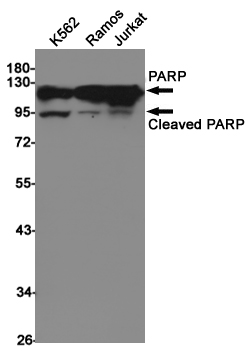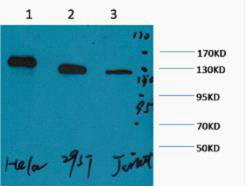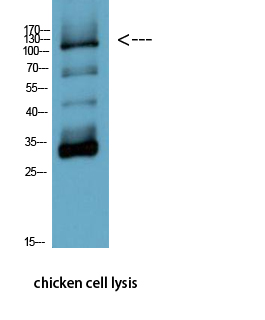-
Product Name
Anti-PARP1 (7A1) Mouse antibody
- Documents
-
Description
PARP1 (7A1) Mouse monoclonal antibody
-
Tested applications
WB
-
Species reactivity
Human, Chicken
-
Isotype
Mouse IgG1
-
Preparation
Antigen: Synthetic Peptide of PARP
-
Clonality
Monoclonal
-
Formulation
PBS, pH 7.4, containing 0.02% sodium azide as Preservative and 50% Glycerol.
-
Storage instructions
Store at 4°C short term. Store at -20°C long term. Avoid freeze / thaw cycle.
-
Applications
WB: 1/1000-3000
-
Validations

Western blot detection of PARP in K562,Ramos,Jurkat cell lysates using PARP (7A1) Mouse mAb(1:1000 diluted).Predicted band size:116KDa.Observed band size:116/89KDa.

Western blot analysis of 1) Hela, 2) 293T, 3) Jurkat, diluted at 1:2000. cells nucleus extracted by Minute TM Cytoplasmic and Nuclear Fractionation kit (SC-003,Inventbiotech,MN,USA).

Western Blot analysis of chicken cell lysis using Antibody diluted at 1:1000
-
Background
Swiss-Prot Acc.P09874.Involved in the base excision repair (BER) pathway, by catalyzing the poly(ADP-ribosyl)ation of a limited number of acceptor proteins involved in chromatin architecture and in DNA metabolism. This modification follows DNA damages and appears as an obligatory step in a detection/signaling pathway leading to the reparation of DNA strand breaks (PubMed:17177976, PubMed:18172500, PubMed:19344625, PubMed:19661379, PubMed:23230272). Mediates the poly(ADP-ribosyl)ation of APLF and CHFR (PubMed:17396150). Positively regulates the transcription of MTUS1 and negatively regulates the transcription of MTUS2/TIP150. With EEF1A1 and TXK, forms a complex that acts as a T-helper 1 (Th1) cell-specific transcription factor and binds the promoter of IFN-gamma to directly regulate its transcription, and is thus involved importantly in Th1 cytokine production (PubMed:17177976). Required for PARP9 and DTX3L recruitment to DNA damage sites (PubMed:23230272). PARP1-dependent PARP9-DTX3L-mediated ubiquitination promotes the rapid and specific recruitment of 53BP1/TP53BP1, UIMC1/RAP80, and BRCA1 to DNA damage sites (PubMed:23230272). Mediates serine ADP-ribosylation of target proteins following interaction with HPF1; HPF1 conferring serine specificity (PubMed:28190768). Mediates the poly(ADP-ribosyl)ation of histones in a HPF1-dependent manner (PubMed:27067600). Involved in the synthesis of ATP in the nucleus, together with NMNAT1, PARG and NUDT5 (PubMed:27257257). Nuclear ATP generation is required for extensive chromatin remodeling events that are energy-consuming (PubMed:27257257).
Related Products / Services
Please note: All products are "FOR RESEARCH USE ONLY AND ARE NOT INTENDED FOR DIAGNOSTIC OR THERAPEUTIC USE"
